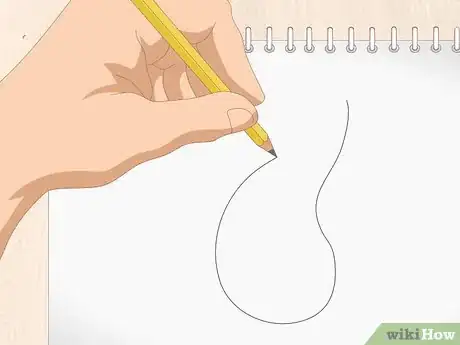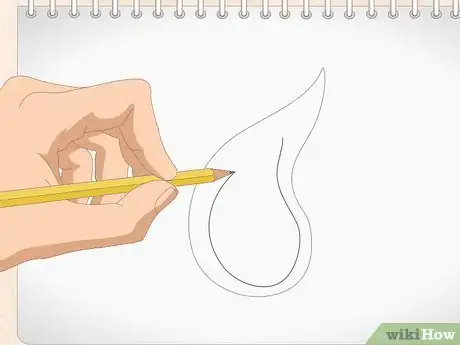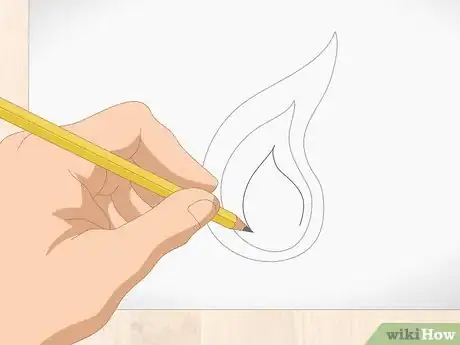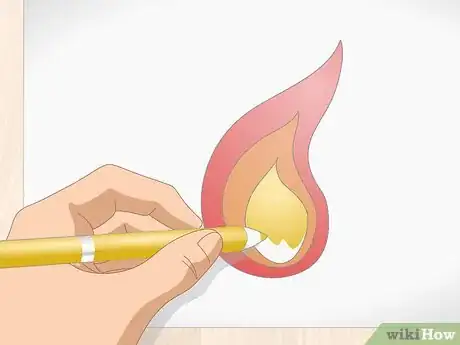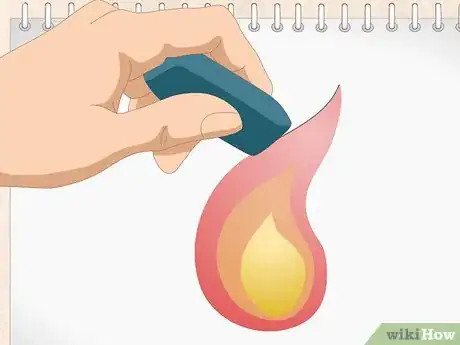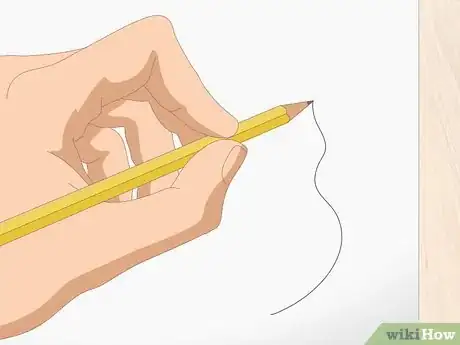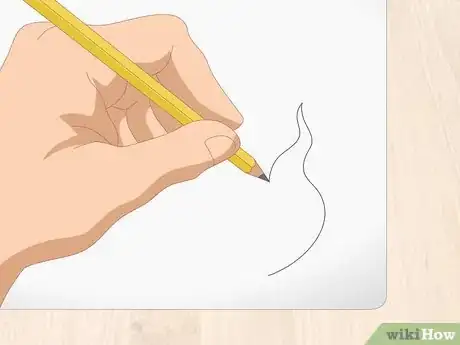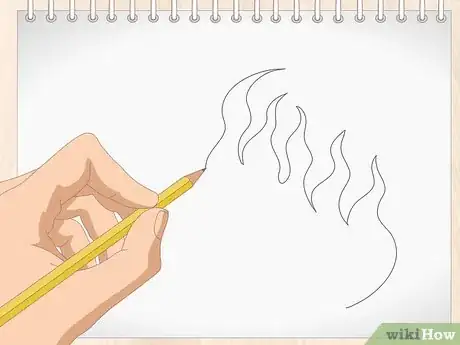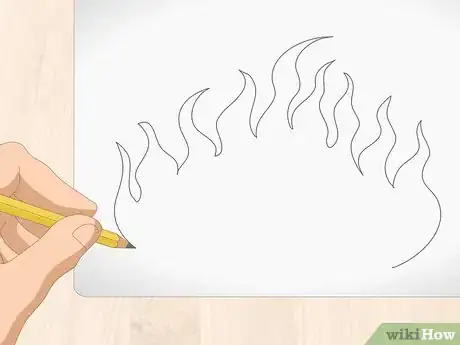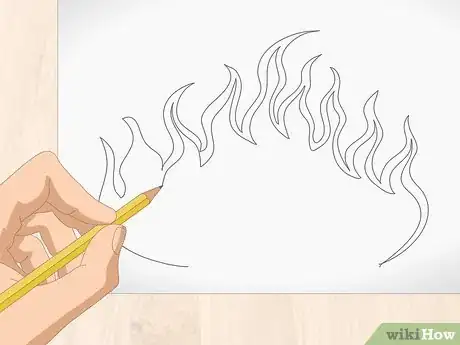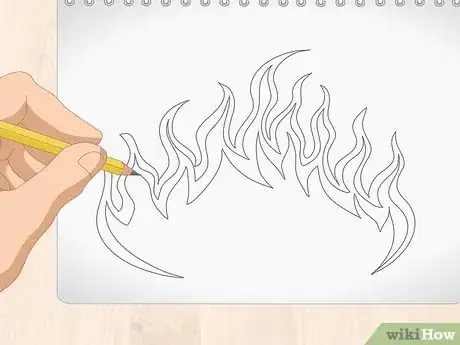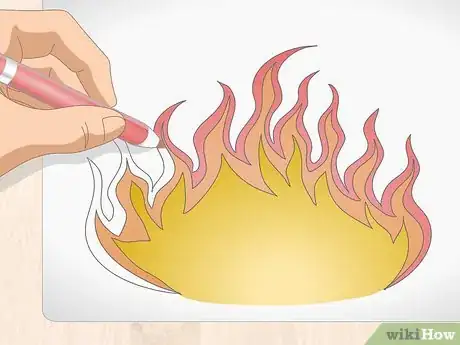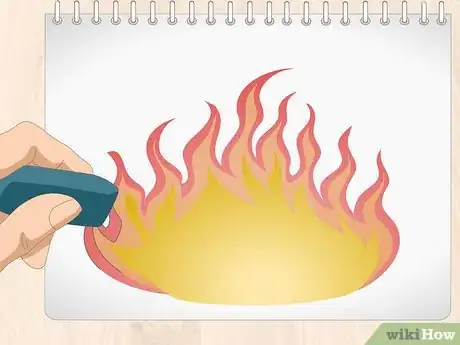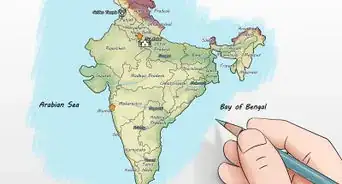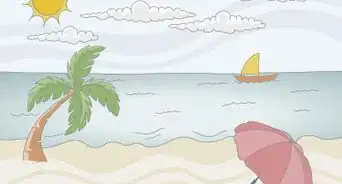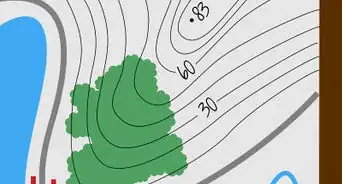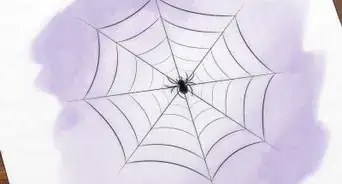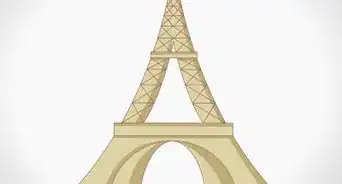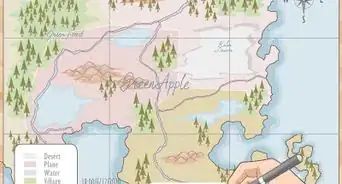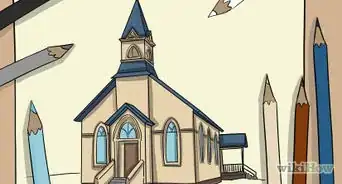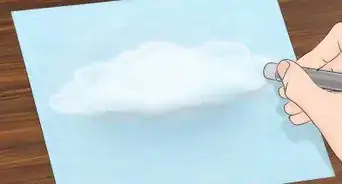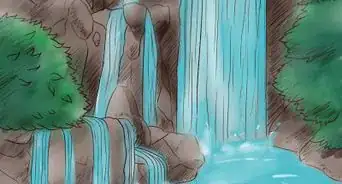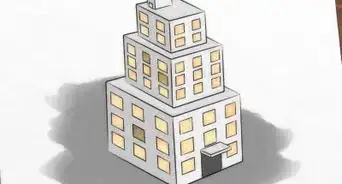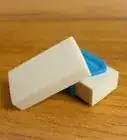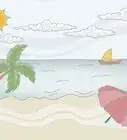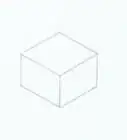This article was co-authored by wikiHow staff writer, Kyle Hall. Kyle Hall works on the content team at wikiHow. He helps manage our team of editors and creates content for a variety of wikiHow projects. Kyle continually looks for new ways to improve the content at wikiHow and make it more helpful and enjoyable for readers. He graduated from Eckerd College in 2015, where he majored in Political Science.
There are 7 references cited in this article, which can be found at the bottom of the page.
This article has been viewed 467,823 times.
Learn more...
Drawing flames can be tricky since they don’t have one solid form or color, but there are some simple tricks you can use to make it easier. Try drawing a single flickering flame first so you can get used to using the right shapes and colors. Then, practice sketching bigger flames once you’ve gotten the hang of it.
Steps
Drawing a Single Flame
-
1Draw a teardrop shape with a wavy point. First, draw the rounded base of the teardrop shape. Then, draw the point coming up off of the base. Make the lines leading up to the point bend gradually 1 to 2 times, like a wave, so your drawing looks like a flickering flame. The waves should start about halfway up the teardrop shape.
-
2Sketch a second teardrop shape inside of the first one. Make it about half the size of the first one, and position it so the base is nearly touching the bottom of the first teardrop. Make the second teardrop wavy just like the first one.
- The second teardrop will give your flame dimension. Later, you can color it a different shade than the first teardrop so it looks like your flame is burning at different intensities like a real flame.
Advertisement -
3Add a third teardrop shape inside of the second one. Make this one about half the size of the second one, and give it the same wavy shape. Draw it near the bottom of the second teardrop shape so their bases are nearly touching.
-
4Color in the teardrop shapes using red, orange, and yellow. Color in the smallest teardrop shape with yellow. Then, color in the medium teardrop shape with orange. Finally, color in the biggest teardrop shape with red. You can use colored pencils, markers, or crayons.
- Flames get lighter in color as they get hotter. Yellow flames are hotter than orange flames, and orange flames are hotter than red flames.[1]
-
5Erase all of the lines you drew in pencil. Removing the pencil outline will make your flame look more realistic. Don’t press down too hard on the eraser or you could smudge the colors. Once you’ve erased all of the pencil marks, your drawing is finished!
- Add a candle and wick to your flame if you’d like! Just draw a thin, vertical cylinder under the base of the flame (for the candle), and connect the top of the cylinder to the flame with a vertical line (for the wick).
Sketching Big Flames
-
1Draw a vertical wavy line. Start where you want the base of the flames to be. Then, draw the vertical wavy line going up toward the top of your page. Stop when the line is about one-third the height you’d like the tallest part of the flames to be. Give the line 2 to 3 waves.[2]
- This is the start of one of the flickering tails on your flames.
-
2Draw another wavy line coming down off the end of the first one to create a point. Start at the top of the first wavy line you drew, and follow the curvature of that line. As you get further away from the starting point, increase the distance between the two lines so you create a thick, wavy tail. Make the distance at the thickest point about one-fourth the length of the first wavy line. Stop when you’re about halfway to the base of the flames. Make this second wavy line about half the length of the first one.[3]
- Your flames will have several of these tails, and they’re what make the flames look like they’re flickering and burning.
-
3Repeat the process and gradually make the flames taller and taller. First, draw a vertical wavy line going up toward the top of your page that's connected to the last point you stopped at. Make it the same length as the first vertical wavy line that you drew. Then, draw another wavy line coming down from the end of the first line to create a new tail on the flame. Keep doing this until you reach the point where you want the center of your flames to be.[4]
- Since you’re making the downward wavy lines half the length of the upward wavy lines, the flames will get taller each time you add a new tail. This is how real flames look—they’re usually tallest in the center and shorter on the ends.
-
4Reverse the process to draw the other side of the flames. Once you’ve reached the point where you want the center (and tallest part) of your flames to be, continue drawing the wavy tails, but now make the downward wavy lines longer than the upward wavy lines. Draw a wavy line down toward the bottom of the page that's connected to the last point you stopped at. Make it the same length as the first wavy line you drew. Then, draw a wavy line up toward the top of the page that’s about half as long. This will cause the tails on the flames to get gradually shorter and shorter. Continue drawing new tails until you reach the base of the flames.[5]
- Try to vary the height and shapes of the tails so they're not an exact mirror of the opposite side. They'll look more realistic that way since flames aren't symmetrical.
-
5Draw a smaller outline of the flames inside of the big one. Follow along with the curvature of the outline you just completed, leaving a narrow space between the two outlines. Adding a second outline of the flames will give your flames dimension. You’ll also be able to color it in a different color later on so it looks like your flames are burning at different temperatures.[6]
-
6Add an even smaller outline of the flames inside of the second one. Do the same thing you did before by following along with the curvature of the second outline. Leave a gap between the third and second outlines. This will give your flames even more dimension and allow you to add a third color.[7]
-
7Color in your flames using red, orange, and yellow. First, color in the smallest outline of the flames with yellow. Then, color in the second outline with orange. Finally, color in the biggest outline with red. You can color in your drawing with colored pencils, markers, or crayons.
- If you don’t have anything to color your drawing in with, shade in your flames with pencil instead. Fill in the biggest flame with the darkest shade, the second biggest flame with the medium shade, and the smallest flame with the lightest shade.
-
8Erase all of the pencil lines in your drawing. Getting rid of the dark pencil outlines will make your flames look more realistic. Be gentle with your eraser so you don’t smudge the color you added. Once all of the pencil lines are gone, you’re done!
Community Q&A
-
QuestionHow do I practice shading to make the fire more realistic?
 Community AnswerYou can experiment with different shades of the colors you would like to use on a separate scrap of paper. Try sketching out a single peak/curve and just shading that. The more you do it, the better you'll become.
Community AnswerYou can experiment with different shades of the colors you would like to use on a separate scrap of paper. Try sketching out a single peak/curve and just shading that. The more you do it, the better you'll become. -
QuestionHow do I make it realistic?
 Community AnswerMake sure to draw detailed curves and remove the guide lines to make your fire look more realistic. You should also make sure to color it to add more realism.
Community AnswerMake sure to draw detailed curves and remove the guide lines to make your fire look more realistic. You should also make sure to color it to add more realism. -
QuestionHow do I do it without guidelines?
 Community AnswerOnce you understand how to draw the flames with guidelines, you'll be able to curve the flames with no guidelines.
Community AnswerOnce you understand how to draw the flames with guidelines, you'll be able to curve the flames with no guidelines.
Things You’ll Need
- Pencil
- Paper
- Colored pencils, crayons, or markers
References
- ↑ http://scienceline.ucsb.edu/getkey.php?key=5621#targetText=As%20this%20is%20true%20for,%2C%20to%20yellow%2C%20to%20white.
- ↑ https://www.youtube.com/watch?v=QT8WN_CJO8s&feature=youtu.be&t=24
- ↑ https://www.youtube.com/watch?v=QT8WN_CJO8s&feature=youtu.be&t=29
- ↑ https://www.youtube.com/watch?v=QT8WN_CJO8s&feature=youtu.be&t=39
- ↑ https://www.youtube.com/watch?v=QT8WN_CJO8s&feature=youtu.be&t=54
- ↑ https://www.youtube.com/watch?v=QT8WN_CJO8s&feature=youtu.be&t=86
- ↑ https://www.youtube.com/watch?v=QT8WN_CJO8s&feature=youtu.be&t=109
About This Article
If you want to draw simple flames, make yourself guidelines to help give the flames the right shape. On a piece of paper, use a pencil to draw 3 mountain-like shapes with straight lines. Underneath those lines, draw the peaks again 2 more times until you have 3 identical lines with a little space between each. To give your flames height and irregularity, draw angled isosceles triangles along the top of the peaks. Once your guide is in place, draw your flames using the triangles as references for where the tips should go. Finally, erase the mountain-shaped guidelines so only your flames are left. For more help, like how to draw cartoon flames, read on.
